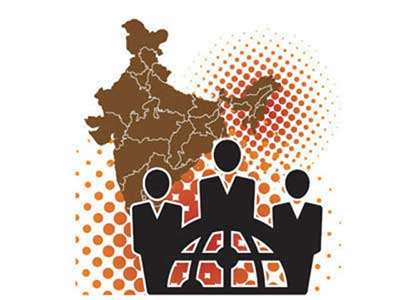Relevance: GS-2: Issues and Challenges Pertaining to the Federal Structure, Devolution of Powers and Finances up to Local Levels and Challenges Therein
Key phrases: Ladakh Autonomous Hill District Council, Article 370, Kargil
Why in news?
Growing demand for Statehood in Ladakh
Analysis:
What is Ladakh’s demand?
- Land, employment and cultural identity of Ladakh be protected under the Sixth Schedule
- Safeguards by amending the Ladakh Autonomous Hill District Council (LAHDC) Act that would clarify the role and responsibilities of the Ministry of Home Affairs (MHA), Lieutenant Governor, urban and rural panchayats vis-a-vis the two councils of Leh and Kargil
- Filling of posts - several persons have retired and the administration had claimed there were more than 20,000 vacancies.
- Another long-standing demand is the route between Kargil and Skardu in territory under Pakistan in Gilgit-Baltistan.
Why this demand?
- They got some protection through Article 35 A. In its absence, they now feel vulnerable
- Allegations that the decisions in the Leh council are dictated by bureaucrats
- Influx of outsiders, for commercial purposes will destroy ecology of the region
- Ladakh does not have a very large population and owing to its border with China has strategic importance
- In absence of a democratically elected government in Ladakh, people are getting disempowered.
Can Ladakh be included in 6th Schedule of the Constitution ?
- National Commission for Scheduled Tribes recommended the inclusion of Ladakh under the Sixth Schedule
- Predominantly tribal (more than 97%), people from other parts of the country had been restricted from purchasing or acquiring land there, and its distinct cultural heritage needed preservation.
- Ladakh is historically perceived as a cosmopolitan region with centuries of multiple cultural settings.
- Changed domicile policy in Jammu and Kashmir has raised fears in the region about its own land, employment, demography, and cultural identity
History of statehood demands in India
- Since independence Indian state has to deal with the demands of separate statehood largely based on language, culture, ethnicity, religion etc.
- Later the basis for separate statehood demands were largely shifted to better governance and greater participation,
- Beginning of 21st century in India also witnessed the creation of three new states- Chhattisgarh, Uttarakhand and Jharkhand and more recently Telangana got the separate statehood.
Reasons behind such demands
- Historical: For instance: demand for the bifurcation of Tamil Nadu was based on the fact that Tamil-speaking region in the past comprised kingdoms centered around Kanchipuram and Tanjore/Madurai
- Administrative: Much of the new demands are a result of uneven growth within states and a perception that splitting large states into smaller chunks will improve administration like developmental lag in Vidharbha due to large size of Maharashtra
- Economic: The sentiment of being deprived even after being rich in natural resources are grounds for the demand of a separate state. like demand for Jharkhand and Chattisgarh
- Socio-Cultural: Even after linguistic divisions, states have a vast diversity which often leads to a feeling of ‘culturally subjugated and victimized’ by some ethnic groups Gorkhaland out of West Bengal, Nagalim demand in North East
Are smaller states beneficial?
- Decentralisation of Power: Smaller administrative units would bring distant provincial governments and administration in remote capitals closer to the people. It will accelerate the pace of modernisation-policy based on local realities.
- The Economic Survey 2016-17 stated that smaller states in India trade more than the rest. New states offered better and efficient administration which leads to creation of infrastructure strengthening the connectivity in the area
- Political stability that arises from better representation of people creates conducive environment for investment in the region. Thereby encouraging regional economic development.
- Resolve the problem of identity crisis among the ethnic groups and enable them to develop their own language and culture thus helping them in getting rid of the ‘feelings of internal colonialism’.
Issues with bifurcation
- Small States could also lead to the hegemony of the dominant community/caste/tribe over their power structures. There can develop, in such States, an aggressive regionalism too leading to the growth of the sons-of-the-soil
- Attainment of Statehood could also lead to emergence of intra-regional rivalries among the sub-regions as has happened in Himachal Pradesh, religious communities as in Punjab and castes/tribes as in Haryana and Manipur,
- Strength of the State legislature would be rather small in such States, the majority of the ruling party or ruling coalition would remain fragile as the present situation in Uttarakhand. and a group of legislators can always break or make government
- In human development indicators also there is a mixed result where smaller states like Haryana, Punjab, Kerala and bigger states like Tamil Nadu, Karnataka, etc. top the list, indicating that Good Governance and not size, what determines development
Way ahead
- Division of states calls for a thorough evaluation of physical features like land equality and topography, agro-climatic conditions, socio-cultural factors
- It is a time for a Second States Reorganization Commission that can redraw Indian Federal map, creating many smaller states and keeping in mind economic viability
- A more effective autonomous institution could also be considered in the form of an empowered body statutorily on par with 6th Schedule areas and assigned, say, all the functional areas under the State List except law and order, maintenance of infrastructure









